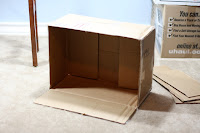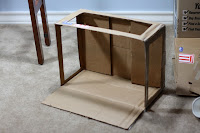My style is a little more traditional and I usually don't do anything innovative. All my skills come from copying others' techniques. Sometimes things turn out same-old, same-old but sometimes I take little techniques from here and there and come up with something pretty cool looking. (I'm just as surprised as anyone when this happens.)
Before I started painting I took a good look at the Nob model. While the level of detail is good, and a huge improvement over the old Macragge push together models, there are a few differences between this Nob and the others in my collection.
First is a metal Nob (left) from the Nob Box set. There is a lot more fine detail on this model than two plastic Nobs, but the size and proportions are very similar to the White Dwarf Nob (middle). The Nob on the right is from the Ork Boyz Box set and suffers from universal Boyz legs. Since his legs come on the accessory sprue, these are the same legs for normal Ork Boyz, and look a little "weedy" in comparison. Otherwise, the detail is good, but is a little angular compared to the metal Nob. (I think the angularity is the result of the plastic or CAD design process, and not part of the style. While the stiches on the metal Nob have an irregular, organic look, the plastic Nob holes look exactly the same.)
The only complaint I have about the White Dwarf Nob is that some of the detail disappears when you rotation the model from front to back. For example, the WD Nob has a stikkbomb clipped to his belt with a round link. But when you turn the model to the side you can see it looks like a cylinder (instead of a round donut shape that a ring should be). From the front it looks great, but as you spin the model it almost looks like something that was made in 2D and converted into 3D. The handle of the stikkbomb has some "webbing" connecting it to the back of the Nob. Look at it from the side, and it looks normal, but turn it around to the back and it just doesn't look as expected. No doubt these artifacts are part of the model making process that makes these guys so cheap to produce. In the end, it really is nit picking, and from a few feet away you'd be hard pressed to notice the difference between the three different Nobz.
All differences aside, I wanted this Nob to match with my current Ork army. Using the same techniques as my Ork horde meant black primer, blank base and lots of dark metal that would match with my Goffs.
First come the base coats in this order: Orkhide Shade, Adeptus Battlegrey, Calthan Brown, Boltgun Metal, Chaos Black and Tin Bitz. After touching up errors, here's what you get:
My Boyz all have black pants and shirts (although I have a few Lootas with brown pants). For the Nob I wanted to try grey pants, to give him a little more detail over the normal troops. It will also help contrast against the black-metal chest and shoulder plates. I used the Chaos Black not just to touch up, but to paint over all of the black primer on areas that I wanted to remain black. I've found the Chaos Black has a little sheen to it, compared to a flat black primer, and this sheen makes for more convincing black metal. You could just use some gloss medium, but since I needed to touch up anyway, it wasn't that much more difficult to repaint all the black.
This step alone took about an hour and 15 minutes, but this is where most of the work is done. Plus at this stage you are painted to a 3-color standard, and sometimes when I am rushing to build a new unit or squad for a tournament, I'll just get to three colors and be good to go.
Next comes the first highlight layer: Knarloc Green, Astronomican Grey, Tausept Ochre and Mirthril Silver.


And now time for the wash: Thraka Green on the skin and Delvin Mud on everything else.


And after that, some final highlights and details to bring it together. Basing is just some Gale Force 9 earth and light brown static grass, to match the rest of my army.


This is the model I submitted to the Waaagh/Bolter and Chainsword painting contest. Zero votes, and rightfully so, there's nothing particularly special about it. Especially compared to the winning entry (although I could have done without the blue stripped pants on that one).
No conversions were allowed in the contest and I wanted to add a power klaw to my Nob, so I did some more work on it. I built the power klaw by scratch from plasticard and tube. I also touched up the metal armor plates, since they didn't turn out black enough for my taste. I also noticed his skin was a little lighter/highlighted compared to the rest of my boys, so I toned it down with another wash of Thraka Green to give it a deep, green glow. With the bosspole, now he's good enough to lead my Boyz into battle.

Total time was about 3 or 3.5 hours, including the PK (which is pretty easy to make), but I did notice I forgot to finish the skull on the bosspole!


































